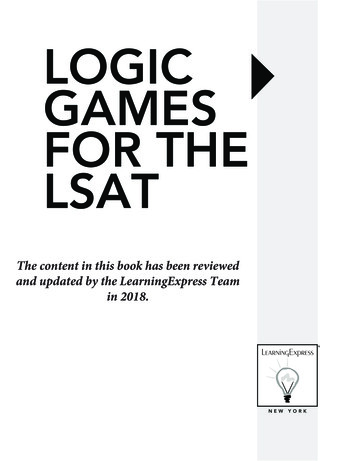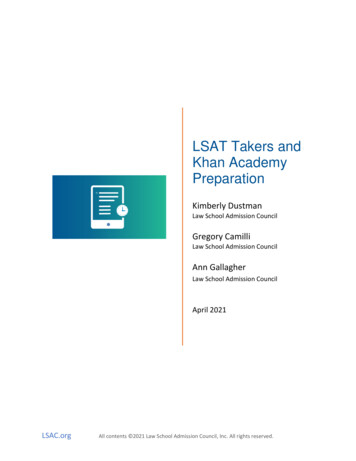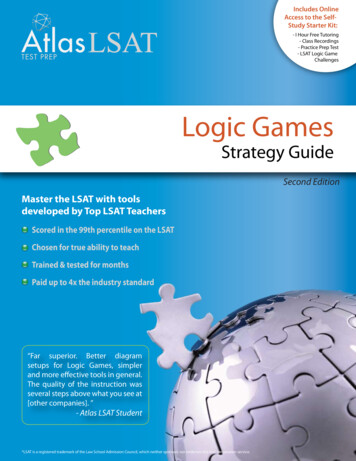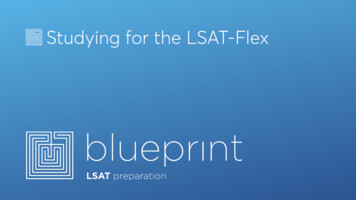
Transcription
LOGICGAMESFOR THELSATThe content in this book has been reviewedand updated by the LearningExpress Teamin 2018. N EWY OR K
CONTENTSIntroduction. vChapter 1:LSAT Logic, Game Types, and General Strategies . 1Chapter 2:Te LearningExpress Test Preparation System . 21Chapter 3:Sequencing Games Review . 39Chapter 4:Selection Games Review . 71Chapter 5:Distribution Games Review. 101Chapter 6:Matching Games Review . 129Chapter 7:Hybrid Games Review. 167Chapter 8:Practice Test 1 . 195Chapter 9:Practice Test 2 . 227iii
blank page
INTRODUCTIONThe Law School Admission Test (LSAT) is the standardized test used by American Bar Association–approvedlaw schools in assessing and admitting law school applicants. If you’re planning to go to law school in theUnited States, taking the LSAT is a must. The test includes five 35-minute multiple-choice sections followed bya 35-minute writing sample. It’s a long test; including breaks, distribution and collection of tests, and other testday procedures, it lasts over four hours.The LSAT is administered by the Law School Admission Council (LSAC), a nonprofit corporation thatassists law schools and applicants with nearly every aspect of the admissions process, from the LSAT to letters of recommendation. (LSAC will be responsible for collecting your application information if you sign upfor their Law School Data Assembly Service.) LSAC usually administers the test four times a year, in February,June, September or October, and December. For law school admission in the fall, you’re often required to takethe LSAT by the previous December, but applicants who are on the ball often the take one of the earlier June orSeptember/October tests—that is, a year or more before they intend to enroll in law school.The LSAT is administered at one of many test centers worldwide. Make sure to register early (atwww.lsac.org) to ensure that you get your choice of testing locations, as they have limited availability and arefilled on a first-come, first-served basis.What’s on the LSATAccording to LSAC, the purpose of the LSAT is to “measure skills that are considered essential for success inlaw school: the reading and comprehension of complex texts with accuracy and insight; the organization andmanagement of information and the ability to draw reasonable inferences from it; the ability to think critically;and the analysis and evaluation of the reasoning and arguments of others.”11 See “What the Test Measures” at www.lsac.org/JD/LSAT/about-the-LSAT.aspv
– I NT RO DU C T IO N –Essentially, the LSAT tests reading comprehension, information management and analysis, and argument analysis. These areas correspond to the three sections on the LSAT. LSAC calls these sections ReadingComprehension, Analytical Reasoning, and Logical Reasoning. Among test-takers and test prep literature, theAnalytical Reasoning section is known as the logic games section, and the Logical Reasoning section is knownas the arguments section.The five multiple-choice sections are broken down as follows, but can appear on the actual test in any order(except for the Writing Sample, which is always last):One Reading Comprehension section One Analytical Reasoning (i.e., logic games) section Two Logical Reasoning (i.e., arguments) sections One experimental section—an unscored section resembling one of these section-types for the sake of futureLSAT test creation (you won’t know which is the experimental section) Writing Sample The sequence of sections and breaks at a typical LSAT administration might be as follows:1.2.3.4.5.6.7.8.Analytical Reasoning (35 minutes)Logical Reasoning (35 minutes)Reading Comprehension (35 minutes)Break (10–15 minutes)Analytical Reasoning, experimental (35 minutes)Logical Reasoning (35 minutes)Break (5 minutes)Writing Sample (35 minutes)So what are these section types all about anyway?Reading ComprehensionThe Reading Comprehension section on the LSAT should be familiar to you already, as it is essentially a spicedup version of similar sections on the SAT and the ACT. You are given four passages on various subjects in thenatural sciences, social sciences, and humanities, each accompanied by five to eight questions (for a total of 26to 28 questions). These questions test your ability to quickly absorb essential information from the passage, understand and interpret the passage, and reason about the ideas presented. You could be asked about the author’sattitude, details in the passage, implications of statements made, main ideas, the function of various parts ofthe passage, or a host of other questions designed to test your level of comprehension. The passages are generally 55–60 lines—about what you’re used to on standardized tests you took in high school—but they are morecomplex than those on the SAT and ACT, drawn from sources ranging from Scientific American to the ABAJournal, and seemingly chosen to make you sweat.vi
– I NT RO DU C T IO N –Logical ReasoningThe Logical Reasoning section of the LSAT may not look like anything you’ve seen on other standardized testsyou have taken. Nonetheless, it tests your ability to carefully read and analyze arguments—skills that the LSACdeems essential for success in law school. Beyond that, it is the only scored section that appears twice on theLSAT. The sorts of ideas and skills tested in this section are truly the bread and butter of legal education andpractice: as LSAC puts it, the skills of “drawing well-supported conclusions, reasoning by analogy, determininghow additional evidence affects an argument, applying principles or rules, and identifying argument flaws.”1A Logical Reasoning section consists of 20–25 short passages, each followed by one or two questions (fora total of 24 to 26 questions). The passages, if followed by one question, are usually three to four sentences long,and comprise an argument of some sort—that is, a presentation of a viewpoint or thesis along with supportingclaims (although often not explicitly so). If followed by two questions, the passages will usually consist of twoshort opposing arguments, often presented as an argument followed by a rebuttal. The vast majority of questions are based on a single argument, rather than the argument-rebuttal format.The questions test precisely the concepts LSAC says they will. They will include asking you to provide missing assumptions in the argument, identify logical flaws, identify statements that would undermine or strengthenan argument, and sometimes even complete an argument (when a part has been left out of a passage).Analytical Reasoning (i.e., Logic Games)The Analytical Reasoning section will be the least familiar section to the majority of test-takers. It consists offour logic games, each accompanied by five to seven questions, for a total of 22 to 24 questions. Each game consists of a setup paragraph, which provide the general parameters of the game, followed by a set of conditions.For example:1. Over the course of seven days, exactly seven diferent Shakespeare plays will be presented in a theater.a. Othello must follow Romeo and Julietb. If Hamlet is shown on Wednesday, Macbeth won’t be shown on any subsequent dayc. Either Te Taming of the Shrew or Hamlet must be shown on Wednesdayd. A Midsummer Night’s Dream will be shown on SaturdayFollowing this game setup, a series of questions are presented that test your ability to understand the mechanics of the game and work with new information presented. For example, one question might ask: if TheTaming of the Shrew is not shown at all, which play cannot be shown on Friday? A likely answer will be Macbeth,since if The Taming of the Shrew is not shown, Hamlet must be shown on Wednesday, and if Hamlet is shownon Wednesday, Macbeth can’t be shown on any later day.Logic games are designed to present information concerning relationships among entities and then testyour ability to both manage the information and reason logically about those relationships. The relationshipscan be spatial, temporal, or logical, and the entities can be persons, places, or things. The example here concernstemporal relationships between things (e.g., that Othello follows Romeo and Juliet).When in the midst of trying to solve a particularly cumbersome or difficult logic game, LSAT test-takersoften find themselves wondering how on earth this could be relevant to law school. LSAC says these highly1 See “What the Test Measures” at www.lsac.org/JD/LSAT/about-the-LSAT.aspv ii
– I NT RO DU C T IO N –unusual mental exercises “reflect the kinds of complex analyses that a law student performs in the course of legalproblem solving.”1 Now, this may or may not be true—and many have difficulty seeing how it could be—but inthe end, that’s beside the point. LSAC thinks logic games are important, and until you finish the last questionon the LSAT, it’s in your interest to think they’re important, too!Altogether, the three section types on the LSAT will call on your powers of rigorous analytical reasoning.This book will help you to master the art of manipulating rules and conditions and to develop expertise withthe logic games section of the LSAT.How the LSAT Is ScoredFour of the five multiple-choice sections are scored, and they will have a considerable impact on your law schoolapplication. The writing sample is not scored, but it is sent to law schools along with your application.The Raw ScoreWhile you will end up answering between 120 and 130 questions (including those on the experimental section)on any given LSAT administration, the four scored multiple-choice sections comprise only 100 to 101 questions.There is no penalty for wrong answers, and each question is weighted equally. Your raw score is simply the number of questions (of the 100 to 101 scored questions) you answer correctly.The Scaled ScoreYour raw score out of 100 or 101 is translated into a scaled score between 120 and 180. This occurs through astatistical process called equating, which attempts to correct for minor differences in difficulty between tests.Every LSAT question is pretested (partially through the experimental sections), and data collected from thesetests enable equating. The original test that the score is equated against was given in June 1991, and the processeffectively ensures that you are competing for your scaled score against a much larger pool of LSAT takers fromvarious test administrations. So don’t worry if all the geniuses you know are taking the test on your test date,and the test seemed harder than your practice LSATs—that won’t prevent you from getting your best score.On the high end, a 180 doesn’t necessarily reflect a perfect raw score. You can miss up to three questionsand often still get a 180. On the low end, to get past a 120, you generally need to get 14 to 17 questions right.Beyond that, for every three raw points you get (every three questions answered correctly), your scaled score willgenerally go up about two points—but that is a rough rule and varies from test to test.The Percentile RankThe score report LSAC sends you will include your percentile rank, which indicates the percent of test-takersover a recent three-year period with scaled scores lower than your scaled score. So if you got a scaled score of 166and your reported percentile rank is 93%, it means that 93% of all LSAT test-takers over some specified periodof time scored lower than 166. Each LSAT will have a table, slightly different from test to test that correlates each1 See “What the Test Measures” at www.lsac.org/JD/LSAT/about-the-LSAT.aspv iii
– I NT RO DU C T IO N –scaled score to a percentile rank; for example, a score of 180 put you in the 99.9th percentile, while a score of151 put you in the 50th percentile. To score better than 90% of test-takers, you need to get around a 164 or 165.In the extreme upper and lower ranges, differences in raw and scaled scores don’t translate to major percentile rank changes: someone who misses one question to get a 180 might be in the 99.9th percentile, while someone who misses 11 questions to get a 173 might be in the 99.0th percentile. But in the middle of the field—forthe majority of law school applicants—LSAT percentile ranks can be very sensitive to changes in raw and scaledscores, and test-takers would be wise to keep this in mind as they look for motivation to keep practicing. Saysomeone misses 40 questions to get a score of 153 and a rank in the 59th percentile. Another person might miss30 questions, and get a score of 159 and a rank in the 79th percentile. That is a 20-point percentile difference!The following table gives a sense of the approximate relationship between raw scores, scaled scores, andpercentile ranks. Please note that this is merely an example meant to illustrate how LSAT score correlationsgenerally work—actual score correlations will vary from test to test.RAW SCORE(how many questions youanswered correctly)SCALED SCORE(your actual LSAT score,reported to law schools)PERCENTILE RANK(the percent of test-takers duringa recent three-year period with alower scaled e LSAT is constructed so that the majority of test-takers won’t finish every section and every problem.Keep this in mind both as you consider this table and as you practice for the test. To maximize your scaled scoreand percentile rank, you are better off ensuring that you correctly answer as many questions as you can, ratherthan rushing through the test attempting to answer every question and ultimately getting fewer correct answers.If you only get to 3/4 of the questions on the test, answer 4/5 of those correctly, and randomly guess on the rest,you are looking at raw score of about 65, which might translate to a scaled score of about 156 and percentileranking of about 70. If you manage to correctly answer all of those carefully analyzed questions, your decisionto focus energies on that select set will result in a raw score of about 80, which might translate to a scaled scoreof about 166 and percentile rank of about 94!ix
– I NT RO DU C T IO N –How the LSAT Is UsedVirtually every law school uses the LSAT as a major factor in the assessment of their applicant pool. Accordingto validity studies conducted by LSAC, the LSAT is a statistically significant numerical predictor of performancein law school (better than undergraduate GPA alone).1 The median statistical correlation between LSAT scoresand first-year performance is 0.33 (a value of 0 indicates a random relationship, and a value of 1 indicates perfect correlation). The idea is that the LSAT directly tests a large portion of the skills necessary for success in thefirst year of law school and beyond. But that claim is largely speculative, and is exceedingly difficult to validate.Students should realize that although the test is a predictor (statistically speaking), it might not be a very strongone—and more importantly, that the LSAC validity study results certainly don’t mean that the test will predictyour performance in law school, let alone your success in a legal career. LSAC itself wisely notes that the LSATis not a perfect predictor, especially because it varies from one school to another in its predictive ability.The LSAT and undergraduate GPA together provide a slightly better predictor of first-year grades thaneither one taken alone (with a median statistical correlation of 0.46). For this reason, and for the sake of convenience, many law schools combine the GPA and LSAT into one index score with which they rank their applicants. Law schools often devise their own formulas for calculating this index score, based on the relativeimportance they attach to the LSAT score versus GPA. Applications are sorted for further review based on thisindex. However, the same caveats apply to the index, so no deterministic conclusions about the future performance of any individual in law school or the legal profession should be made based on that measure!How to Use This BookThis book is designed to help you master the art and science of logic games. The Analytical Reasoning (logicgames) section of the LSAT is one of the most unusual standardized test sections out there, and most test-takerswill be unfamiliar and unpracticed with the skills it requires. Fortunately, there are a limited number of principles behind both the mechanics of the games and the proper approach to the games, which when studied andpracticed, will make the Analytical Reasoning section just as approachable and tractable as any other section.There are a limited number of game types, question types, and specific strategies and skills tested—and onceyou learn them you will become a confident logic gamer.This book breaks down the LSAT logic games into five types—sequencing games, selection games, distribution games, matching games, and hybrid games—with a chapter devoted to each. Each chapter breaks downthe essential components of that game type, and provides specific tips and strategies for mastering it.First, familiarize yourself with the LearningExpress Test Preparation System in Chapter 2. There, you willfind suggested schedules for working through the rest of the book. Make sure to read the general strategies inChapter 1. Beyond that, you will be advised that if you have the time, you should work through each chapter sequentially, carefully reading the tips and strategies at the beginning of the chapter, working through each practice game and the answer explanations to understand how the strategies should be applied to each, and makingsure to apply them to each new practice game as you go along. If you are crunched for time, you will be advised1 See ormance.pdfx
– I NT RO DU C T IO N –to start by taking one of the practice tests at the end of the book to assess which games you need the most helpwith. Then go to those chapters, and work through the tips, strategies, and practice games. Either way, makesure to take both practice tests, at least one of which you should do after working through the strategy chapters,to see your progress!When working through practice games, whether in the strategy chapters or on the practice tests, makesure to mix timed and untimed trials. There are eight practice problems in each chapter, so consider doing fourgames untimed, and then four games in a row with a 35-minute total time limit (since you will have to do fourgames in 35 minutes on the actual LSAT). The untimed games will help you to practice the thought processesand diagramming techniques recommended, and to carefully and deliberately apply the tips and strategies youhave learned. The timed games will help you practice efficiency with those processes and learn to quickly andefficiently apply the proper techniques. Over time, this approach will build speed, efficiency, and accuracy.After every practice game or group of four games, make sure to review the detailed answer explanations,even for answers you got right. Your main concern, especially in the initial practice games for each game type,is to ensure that you are tackling the game and questions with the right thought processes and approaches, andreasoning in a sound, logical manner. This comes from reviewing the answer explanations, comparing your approach to that presented in the explanation, and (if needed) determining how you can improve your approachthe next time around. Don’t get into a logic game rut: stay active and engaged with the practice and explanations by reflecting on what your thought processes were when working through a practice game, and constantlystrive to amend those processes so that you won’t miss similar question types, deductions, or connections in thefuture. The book is carefully designed to help you master logic games, but your success in doing so depends onhow much you put into it!xi
blank page
C H A P T E R1LSAT Logic, GameTypes, and GeneralStrategiesLSAT logic games are ultimately about logical reasoning. Tey require general logical reasoning, such as realizing that if A comes before B, then B cannot be frst in a sequence and A cannot be last in a sequence. Tis kindof logical reasoning is ubiquitous in logic games.Logic games also require that we translate sentences into formal logical constructions using “logical connectives” (in particular, “and,” “or,” “not,” and “if-then”), and that we manipulate the resulting constructions.This kind of logical reasoning is more complex and may be unfamiliar to many students.Know Your LSAT Formal LogicIn the following discussion, we describe how statements are formed using logical connectives and how to reasonwith such statements. Our building blocks are two “simple” statements, which we call statement “A” and statement “B.” “A” and “B” can stand for any declarative statement, but on the LSAT, these statements will often bebits of concrete information presented in the logic game setup, such as “Abigail is in the morning section” or“Brian is in the morning section.”1
– LSAT LOGI C, GAME T Y P E S , A N D G E NE RAL S T RAT E G IE S –Conjunctions (“A and B”)A conjunction uses the word “and.” It means that both statements are true. If you’re told that A and B are true,then the conjunction is “A and B.”An example would be “Abigail and Brian are both in the morning section.”Disjunctions (“A or B”)A disjunction uses the connective “or.” It means that either one or the other statement is true, or both are true.The disjunction “A or B” means that either A or B is true, or both are true. An example is the statement “EitherAbigail or Brian is in the morning section.” Note that this disjunction is inclusive—both A and B can be true.An exclusive disjunction is where only one statement, not both, can be true.Negations (“not A”)You can also negate a single statement with the connective “not” (it’s called a connective even though it operateson just one statement, rather than connecting two statements). This is very straightforward: if you want to saythat A is not true, you say “not A.” It can be symbolized with an equal sign with a line through it: ANote that if we negate the negation of statement A—that is, if we say “not A” is not true—we end up with“not (not A),” which is the same things as just saying “A.” Think about it this way: if you say that it is not truethat A is not true, you are really saying that A is true. A double negative in English grammar works the sameway. If you say that you are not unhappy, that means you are happy.Negating Conjunctions and Disjunctions (“not (A and B),” “not (A or B)”)We have considered the connectives “and,” “or,” and “not.” Before turning to the other connectives, we must takea look at how to apply connectives to one another—in particular, how to negate conjunctions and disjunctions.First, keep in mind that what results from using a connective on any statement is itself a new statement,which can be a part of yet another statement using a connective. So if we create the conjunction “A and B,” thisnew statement “A and B” can be negated to create “not (A and B).”What does “not (A and B)” mean? It means that it’s not the case that both A is true and B is true. In otherwords, one of the two statements (or both) must be false. Using the previous example, the statement “not (A andB)” tells us that either Abigail is not in the morning section or Brian is not in the morning section, or neitherare in the morning section. Notice that you can also say “either A is not the case or B is not the case.” This issimply the disjunction “not A or not B.”In fact, these two statements are equivalent: not (A and B) not A or not B.Saying A and B can’t both be true (“not (A and B)”) is the same as saying at least one isn’t true (“not A ornot B”).It is important to use parentheses to avoid confusion. For example, “not (A and B)” isn’t the same statement as “not A and B.” The first one, “not (A and B),” says that A and B can’t both be true, so B could be true, aslong as A is not true. The second one, “not A and B,” says “A is not true” and “B is true.” These two are clearlynot equivalent statements.So far we have seen how to negate a conjunction “A and B.” What about negating the disjunction “A or B”?The disjunction “A or B” tells us that at least one statement is true. So “not (A or B)” means neither statement istrue. This is the same as both not A and not B are true (“not A and not B”).2
– LSAT LOGI C, GAM E T YP E S , A N D G E NE RA L S T RAT E G IE S –Therefore, these two statements are equivalent: not (A or B) not A and not B.Saying that it can’t be true and that at least one statement is true is the same as saying that both A is nottrue and B is not true.Conditionals (“if A, then B”)The most important logical concept on the LSAT is the conditional statement, which takes the form “if A, thenB.” It is symbolized with an arrow: A S B.This conditional means that if statement A is true, then statement B is true. Before we can understand howto work with conditional statements, it’s worth pausing to figure out what this means exactly in the logical sense,which is similar to, but slightly different from the everyday sense.The Logical Meaning of ConditionalsWhen people make “if A, then B” statements in everyday English speech, they usually have some sort of causalconnection between A and B in mind. A common example of an everyday English “if-then” statement is “if it israining, then I will bring my umbrella.” The idea is that a causal connection exists between the first part of thestatement and the second part—you bring your umbrella because it is raining. However, this statement is falsewhen it is raining but I do not bring my umbrella, because the causal connection clearly does not hold (the raindid not cause me to bring my umbrella). Therefore, we do not have a clear understanding of the circumstancesthat make the conditional statement true. For example, is the conditional statement true when I bring my umbrella even though it is not raining? Further, this example doesn’t address the confusion students often feel whenthey encounter if-then statements on the LSAT that do not have a clear causal connection, like “if car A has aspoiler, then car B has performance tires.” What does car A’s spoiler have to do with car B’s performance tires?How is that the same as me bringing an umbrella because it is raining?In short, in the logical meaning of conditionals, there is no causal connection between A and B. It simply means that when A is true, B is also true. Think of it as “if A is true, then B must be true.” We don’t knowwhy the truth of A guarantees the truth of B (why car A having a spoiler guarantees that car B has performancetires), but from a logical perspective (which is the only perspective of the LSAT logic games!), we don’t care. Allwe care about is that fact: when car A has a spoiler, car B must have performance tires.Further, the conditional statement must be true in all circumstances except when A is true and B is false.So, a conditional statement is true when A is true and B is true, when A is false and B is true, and when A isfalse and B is false.This answers our question about what happens when it isn’t raining, but I bring my umbrella anyway:What happens is that the statement is true. You might wonder how this could be.Remember that there is no causal connection in the strictly logical “if-then” statement. Even still, you mighthave issues with conditionals that are true whenever A is false but B is true—that’s ok, but for the purpose ofthe LSAT, you need to accept it. Why does this even matter for the LSAT? Well, let’s take a look at an example.Suppose that a logic game gives us the following set of restrictions:If Brian is in the afernoon section, then Charles is in the evening section.If Danielle is in the morning section, then Elizabeth is also in the morning section.3
– LSAT LOGI C, GAME T Y P E S , A N D G E NE RAL S T RAT E G IE S –Now suppose that in the course of trying to answer a question, we want to check whether the following is acceptable for Brian and Elizabeth, without even knowing where Charles and Danielle are assigned.Morning:Afernoon:Evening:ElizabethBrianWe need to see whether this assignment violates either of our two restrictions. Given our understanding of thelogic of conditionals, we can quickly check the assignment against each of the conditional statements—and aslong as either the first part of the conditional statement is false or the second part of the conditional statementis true (or both), we know that that conditional statement is true (that is, the restriction is not violated).For the first conditional statement, we see that the frst part of the conditional (that Brian is in the afternoon section) is false (because according to this assignment, Brian is in the evening se
The Law School Admission Test (LSAT) is the standardized test used by American Bar Association-approved . practice: as LSAC puts it, the skills of "drawing well-supported conclusions, reasoning by analogy, determining . the logic games section of the LSAT. How the LSAT Is Scored Four of the five multiple-choice sections are scored, and .










